.
- Steelhead trip 2013
- Meeting 2014
- BC Trip 2014 / 1
- BC Trip 2014 / 2
- BC Trip 2014 / 3
- BC Trip 2014 / 4
- BC Trip 2015
- by W. Fabisch
- Angling or fly fishing
- Norvise Tuning
- Norvise Tuning Two
- How to use while...
- With strike Indicator
- How to fish nymphs
How to use while fly fishing and tying
Assistance how to use while fly fishing or tying
For some materials, tools or accessories the description for use or mounting is not entirely clear. Instructions how you use helpful accessories during fly fishing and tying.
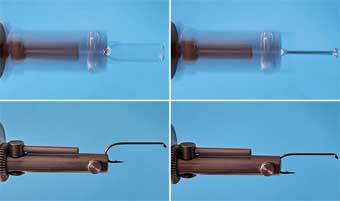 The pictures on the left show a hook placed incorrectly. In a static position, this doesn´t seem a big problem. If, however, the vise is rotated quickly, it
looks as though the hook had two shanks. The farther apart these two shanks appear, the farther out of the axis of rotation the hook is mounted. The pictures
on the right show a hook mounted correctly. Even when rotated, only one shank is visible.
The pictures on the left show a hook placed incorrectly. In a static position, this doesn´t seem a big problem. If, however, the vise is rotated quickly, it
looks as though the hook had two shanks. The farther apart these two shanks appear, the farther out of the axis of rotation the hook is mounted. The pictures
on the right show a hook mounted correctly. Even when rotated, only one shank is visible.Mounting the Hook in Your Norvise
.
To be able to use the Norvise´s fast rotation to your advantage, the hook needs to be mounted correctly!
.
Again and again I see tiers having problems with the Norvise - a perfect tool - because the hook has not been mounted in the correct way. Unfortunately, even small deviations from the ideal position may lead to serious problems.
.
To work properly, the hook shank has to be placed exactly in the axis of rotation of your vise. Any misplacement will lead to a dynamic unbalance rendering tying all but impossible.
.
The farther outside the center of rotation he shank is placed, the worse the unbalanced effect.
.
The pictures on the left show how the shank is placed considerably too high, illustrating the effect when the vise is being rotated.
.
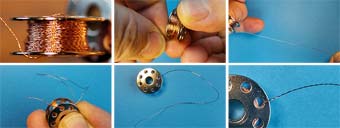 1. Spool.
2. Secure wire wraps with one finger and use the other hand to push the wire out of the hole in the spool's rim. 3. Take the length of wire you need off the spool.
Push it through the hole completely. 4. Now push it through the hole completely. 5. A little crease is enough to secure the wire. 6. As you can see here, the hole
in the rim is sufficient to keep the wire from coming off the spool.
1. Spool.
2. Secure wire wraps with one finger and use the other hand to push the wire out of the hole in the spool's rim. 3. Take the length of wire you need off the spool.
Push it through the hole completely. 4. Now push it through the hole completely. 5. A little crease is enough to secure the wire. 6. As you can see here, the hole
in the rim is sufficient to keep the wire from coming off the spool.Fabisch Ribbing Wire
.
Ribbing wires have a fatal tendency to act like spiral springs - as long as you let them. As soon as you start a new spool, the wire becomes loose right to the very core. Frequently, wire is being sold on spools that don't provide elements to stop the wire from coming loose. This is different in the spools I use for my ribbing wire. My wire also has a tendency to come undone, but I sell it on standard spools for sewing machines. You may put the end of the wire through any of the holes punched into the rim of the spool and thus keep it safely on the spool.
.
On the picture you see the wire (two intertwined strands in this case) on its metal spool. Threading the loose end through any of the holes is enough to secure the thread on the spool.
.
.
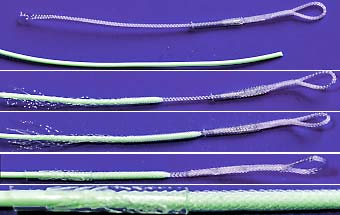 In the bottom part of the picture you can see how the sleeve keeps cord and braid together.
In the bottom part of the picture you can see how the sleeve keeps cord and braid together.The Fabisch Loop-on
.
This loop-on puts a reliable and solid loop on the end of your fly line without lots of fuss. Many new fly lines already come with a built-in loop, but be careful. In some cases this loop may consist only of the fly lines coating and thus lack the strength of the line, which comes mostly from the core, and not the coating. These loops without the core material in it are prone to rip when you least like it.
.
How to Apply the Loop-On
1. The loop-on and the tip of the fly line.
2. Push the fly line into the braid.
3. Push it all the way to the little plastic sleeve.
4. Push the sleeve over the end of the fly line.
5. Snip off the stubs - done.
.
.
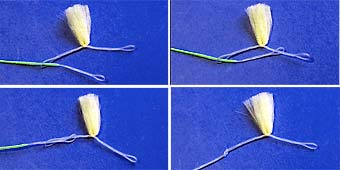 This system is called loop-in-loop. There is always a free lop at the
end for strike indicators, shock absorbers or what have you. To remove the indicator, just go through the steps in reverse direction. My indicator is designed
for multiple use
This system is called loop-in-loop. There is always a free lop at the
end for strike indicators, shock absorbers or what have you. To remove the indicator, just go through the steps in reverse direction. My indicator is designed
for multiple usethe Fabisch Strike Indicator
.
There are many versions of strike indicators for flyfishers on the market, even some which - in my opinion - place their users outside the ranks of fly fishers. I would not want to use solid chunks that can float a weight of 4 grams and more, but that is up to each of you. My strike indicator has practically no buoyancy and its main purpose is to mark the tip of your flyline. As nymph fishers frequently use very long leaders, your strike indicator should pass through your rod's guides when you have to pull it in to land a fish.
.
How to join your indicator to the fly line
1. Pull the loop at the tip if your flyline through the first loop on the indicator.
2. Pull the second loop in the indicator through the loop at the tip of your fly line.
3. Pull the indicator all the way through.
4. Pull both loops together as shown on the photograph and tie or loop your leader to the front loop of your indicator.
.
the product - Strike Indicator
.
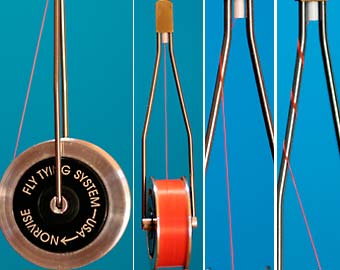
the Norvise Bobbin
.
The Norvise bobbin has everything you might want in a bobbin for fly tying. Unfortunately the instructions that come with it lack some of its advantages, so I'll try to fill in the gap.
.
1. It is essential to check for the right direction for the automatic spool to turn when using this bobbin. It is easy if you just look at the little arrow on the side of the spool.
2. It won't work right if you try to thread the thread directly from the spool into the little ceramic tube!!! Of ourse, the automatic system will work, but it won't hold the weight of the bobbin with the spool inserted and will therefore always yield about 40 cm of thread.
3. If your spool is less than half full, it may be sufficient to wrap your thread once around one of the prongs that hold the spool.
4. If your spool is full, it may take up to three wraps to make sure the spool works properly.
.
.
.
.
Wolfgang Fabisch, Nürnberger Str. 45, 90542 Eckental/Germany
✆ Germany 011 49 9126 288640, Fax 011 49 9126 288643, Wolfgang Fabisch